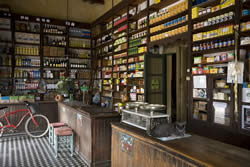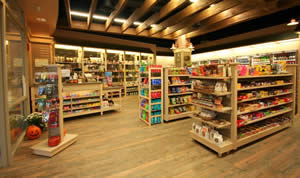Difference between Grocery Store and Convenience Store
Key Difference: A grocery store is a store that sells food items to customers and nothing else. A grocery store is a small version of a supermarket that allows people to purchase dry food items, canned goods and exotic foods or spices from other countries. Convenience stores are small stores that are open for long hours and offer a small variety of goods. Convenience stores stock on goods that a person might require in an emergency and would not like travelling long distances for it.
Grocery store and convenience stores are very similar in nature and cannot be effectively differentiated. The location of both of these stores was located closer to residential areas for providing convenience. Both of these stores provide dry grocery items as well as additional items. A main difference between the two is that convenience stores offer ready-made food items, which is absent in a grocery store. Let’s look at the minute differences that make them stand apart.
 A grocery store is a store that sells food items to customers and nothing else. A grocery store is a small version of a supermarket that allows people to purchase dry food items, canned goods and exotic foods or spices from other countries. Grocery stores were the place where people would purchase their food, fruits and vegetables before. Before the World War II, neighborhood grocery stores were the only place where people would purchase their groceries. This all changed after the War, when supermarkets or self-service grocery stores started becoming a trend. Supermarket provided additional supplies such as wet groceries, ready-made food, cleaning supplies and other household items.
A grocery store is a store that sells food items to customers and nothing else. A grocery store is a small version of a supermarket that allows people to purchase dry food items, canned goods and exotic foods or spices from other countries. Grocery stores were the place where people would purchase their food, fruits and vegetables before. Before the World War II, neighborhood grocery stores were the only place where people would purchase their groceries. This all changed after the War, when supermarkets or self-service grocery stores started becoming a trend. Supermarket provided additional supplies such as wet groceries, ready-made food, cleaning supplies and other household items.
A grocer, the owner of the grocery store, would stock the store with exotic as well as local supplies. He would also employ young store hands that would help in bagging groceries, taking groceries out and delivering them. The grocer would specifically be in charge of jotting down customer bills and maintaining accounts. The store would have a counter, behind which the grocery and his helpers would be. They would go around the whole store and bag whatever the customer requires. The people could then put the groceries on credit, which would be cleared at the end of the month. Many people could also give their orders over the phone, which would be delivered to them.
The shift from grocery stores to supermarkets began with the introduction of cheaper vehicles. Vehicles allowed people mobility, which did not limit them to the groceries in the neighborhood. They could travel to different places and sample foods and groceries from them firsthand. The mobility also contributed to the success of the supermarket. Though grocery stores have become obsolete in many developed countries, developing countries still keep grocery stores. In India, these stores are called as Kirana stores. Grocery stores are not limited to keeping just dry food and spices and have also expanded to include some daily used household items such as cleaning supplies, soaps, tissues, etc. Some grocery stores also specialize in foods and goods of a certain nationality, such as Middle-Eastern, Italian or Indian. These stores are known as ethic markets. Some grocery stores also predominantly sell snack foods and sandwiches are known as convenience stores or delicatessens.
 Convenience stores are small stores that are open for long hours and offer a small variety of goods. These stores are also known as corner store, corner shop, party store and bodega (in Spanish speaking areas). Convenience stores stock on goods that a person might require in an emergency and would not like travelling long distances for it. These stores are located in busy streets, street corners, highways, etc. They are used by both locals as well as travelers. Convenience stores are commonly connected with a highway, to provide customers with eatables, drinks, bathroom, tobacco, cigarettes, alcohol, etc. It also has limited grocery items such as milk, ice cream, candy, soft-drinks, etc.
Convenience stores are small stores that are open for long hours and offer a small variety of goods. These stores are also known as corner store, corner shop, party store and bodega (in Spanish speaking areas). Convenience stores stock on goods that a person might require in an emergency and would not like travelling long distances for it. These stores are located in busy streets, street corners, highways, etc. They are used by both locals as well as travelers. Convenience stores are commonly connected with a highway, to provide customers with eatables, drinks, bathroom, tobacco, cigarettes, alcohol, etc. It also has limited grocery items such as milk, ice cream, candy, soft-drinks, etc.
The stores are located in places where they are easily available and are open longer hours, with some even being open 24 hours, such as 7-11. Some of these convenience stores can also offer liquor if they have the license. Normally, they only keep beer and wine, with more hard liquors available in proper liquor stores. Convenience stores are also popular for offering lottery tickets, scratch cards, newspapers, magazines, slushies, soft drinks, coffee, tea, sandwhiches, bagels, hot dogs, pizza, etc. They may also offer money order and wire transfer services. Convenience stores are also popular for contraceptives and hygienic products such as toilet rolls, soaps, etc. Stores that are near fishing destinations may also provide live bait.
Many stores follow a similar format to establish the store. The checkout counter is near the front of the store in a corner. There a 2-3 aisles that are loaded with products, with cigarettes, lottery tickets, money order services and magazine racks up front near the checkout counter. The ready food is placed near the back to one side with microwave ovens, coffee machines and slushie machines near the food. The store comes with an attached bathroom for the customers. There will also be a cooler for keep drinks, ice cream and other foods that require cold. The stores that are open 24/7 may also have a bullet-proof glass on the checkout counter to protect their employees from robbers. Convenience stores offer slightly higher prices compared to supermarkets and hypermarkets, and also provide faster service.
Image Courtesy: everywheremag.com, kazooga.com









Add new comment